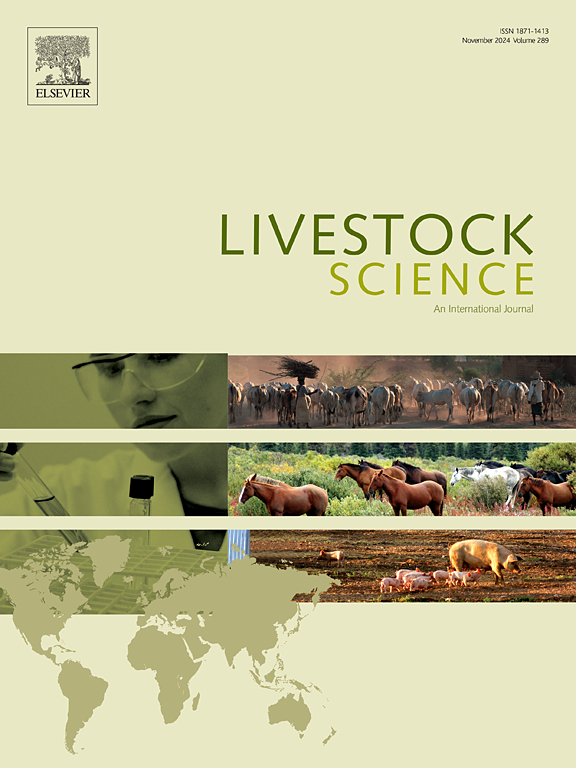Effect of feeding strategy on piglet growth and survival and milk production of loose-housed lactating sows
IF 1.9
3区 农林科学
Q2 AGRICULTURE, DAIRY & ANIMAL SCIENCE
引用次数: 0
Abstract
The aim of this study was to test how an increased number of daily feedings and different dosing speeds affect piglet growth and survival, sow BW and back fat thickness, and milk production of loose-housed lactating sows. A total of 424 parity 1 to 5 sows were allotted to one of three feeding strategies. All sows were fed the same lactation diets according to the same feeding curves. The control group (Fast3) was fed three times per day, and the entire ration was dosed at one time (high speed) into the trough. In the second group (Slow3), sows were also fed three times per day, but here, the ration was dosed at slow speed doses of 100 g of feed followed by a 60 second pause before feeding the next 100 g dose, resulting in sows standing up for >20 min/feeding. In group three (Slow6), sows were fed six times per day at low speed. A colostrum sample was taken 12 h after farrowing and analyzed for DM, lactose, protein, casein, fat, immunoglobulins, and zinc. After farrowing, litters were standardized to 15 piglets. At standardization, d 6, d17, and at weaning, litter weight, litter size, sow BW and back fat thickness were registered. Milk samples were obtained at d 6 and 17 and analyzed for DM, lactose, protein, casein, fat, and zinc. Feed intake was greater in the Fast3 (7.62 kg/d) sows than in the Slow3 (7.45 kg/d) and Slow6 (7.50 kg/d) sows (P < 0.001). Sows in all three groups had the same litter size at weaning, average milk yield, and average daily litter gain. The composition of colostrum was not affected by feeding strategy. At d 6, the milk content and total daily output of DM, fat, protein, casein, and lactose were unaffected by feeding strategy. There was a higher zinc concentration in the milk of Fast3 sows compared to Slow6 sows (P < 0.05) at d 6 of lactation. The DM, protein, and fat concentrations and total daily output of nutrients were not affected by feeding strategy at d 17. The lactose concentration of the milk at d 17 was lower in Slow3 sows than in Fast3 and Slow6 sows (P < 0.05). The body weight and back fat thickness of sows were similar in all three groups. In conclusion, slower dosing of the feed ration or more daily feedings did not affect piglet survival.
饲喂策略对散养哺乳母猪仔猪生长、存活及产奶量的影响
本试验旨在研究增加日投喂次数和不同投喂速度对散养哺乳母猪仔猪生长和存活、母猪体重和背膘厚以及产奶量的影响。共有424头1 ~ 5胎母猪被分配到三种喂养策略中的一种。各组母猪按相同的饲喂曲线饲喂相同的泌乳日粮。对照组(Fast3)每天投喂3次,整只饲料一次性(高速)投入槽中。在第二组(Slow3)中,母猪也每天饲喂3次,但在这里,母猪以100 g饲料的慢速剂量饲喂,然后在饲喂下一个100 g剂量之前暂停60秒,导致母猪站立20分钟/次饲喂。第三组(Slow6)每天低速饲喂6次。产后12小时取初乳样品,分析DM、乳糖、蛋白质、酪蛋白、脂肪、免疫球蛋白和锌。产后,每窝标准化为15头仔猪。在标准化、第6天、第17天和断奶时,分别记录窝重、窝重、母猪体重和背膘厚。在第6天和第17天获得牛奶样品,分析DM、乳糖、蛋白质、酪蛋白、脂肪和锌。Fast3母猪的采食量(7.62 kg/d)高于Slow3母猪(7.45 kg/d)和Slow6母猪(7.50 kg/d) (P <;0.001)。三组母猪的断奶产仔数、平均产奶量和平均日产仔增重相同。饲喂策略对初乳成分无明显影响。第6 d时,泌乳量和DM、脂肪、蛋白质、酪蛋白和乳糖的总日产量不受饲喂策略的影响。Fast3母猪乳中锌含量高于Slow6母猪(P <;0.05)。饲喂策略对第17天的DM、蛋白质和脂肪浓度以及总营养物质日产量没有影响。第17 d时,慢3母猪乳中乳糖浓度低于快3和慢6母猪(P <;0.05)。三组母猪体重和背膘厚基本一致。综上所述,较低的饲料剂量或较长时间的日采食量并不影响仔猪的存活率。
本文章由计算机程序翻译,如有差异,请以英文原文为准。
求助全文
约1分钟内获得全文
求助全文
来源期刊

Livestock Science
农林科学-奶制品与动物科学
CiteScore
4.30
自引率
5.60%
发文量
237
审稿时长
3 months
期刊介绍:
Livestock Science promotes the sound development of the livestock sector by publishing original, peer-reviewed research and review articles covering all aspects of this broad field. The journal welcomes submissions on the avant-garde areas of animal genetics, breeding, growth, reproduction, nutrition, physiology, and behaviour in addition to genetic resources, welfare, ethics, health, management and production systems. The high-quality content of this journal reflects the truly international nature of this broad area of research.
 求助内容:
求助内容: 应助结果提醒方式:
应助结果提醒方式:


